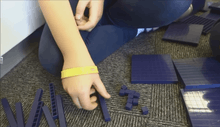Base ten blocks

Base ten blocks, also known as MAB (multibase arithmetic blocks) blocks or Dienes blocks (after the mathematician and educationalist Zoltán Pál Dienes who promoted their use), are a mathematical manipulative used by students to learn basic mathematical concepts including addition, subtraction, number sense, place value and counting. The student can manipulate the blocks in different ways to express numbers and patterns. Generally, the 3-dimensional blocks are made of a solid material such as plastic or wood and come in four sizes to indicate their individual place value: Units (one’s place), Longs (ten’s place), Flats (hundred’s place) and Blocks (thousand’s place).[1] There are also computer programs available that simulate base ten blocks.
Use in mathematics instruction
Base ten blocks are popular in elementary school mathematics instruction. They are frequently used in the classroom by teachers to model concepts, as well as by students to reinforce their own understanding of said concepts. Physically manipulating objects is an important technique used in learning basic mathematic principles, particularly at the early stages of cognitive development. Studies have shown that their use, like that of most mathematical manipulatives, decreases as students move into higher grades.[2]
See also
References
External links
- Educational and Supplemental Materials for K-12
- http://nlvm.usu.edu/en/nav/frames_asid_152_g_1_t_1.html?from=topic_t_1.html
- http://www.mathsolutions.com/documents/0-941355-57-8_L.pdf
- https://web.archive.org/web/20090903152814/http://www.susancanthony.com:80/Resources/base10ideas.html